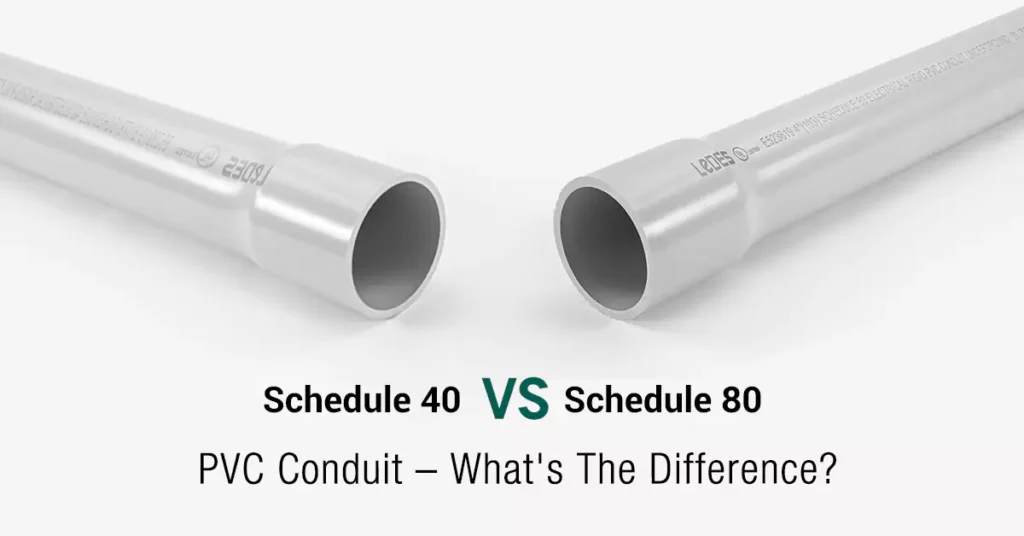
Índice
Qual a diferença entre os conduítes de PVC Schedule 40 e Schedule 80? Essa é uma ótima pergunta. A maioria das publicações dirá que a chave é a espessura da parede. Isso mesmo, mas não tudo. Listaremos 7 pontos de diferença nesta publicação e permitiremos que você entenda completamente a diferença entre os dois. Então, vamos começar.
- Os conduítes de PVC Schedule 40 e Schedule 80 são feitos de cloreto de polivinila (PVC) e atendem aos padrões ASTM aplicáveis.
- Eles podem passar por processos de certificação para atender aos padrões de segurança e garantir a qualidade.
Os conduítes de PVC Schedule 40 e Schedule 80 são fabricados com policloreto de vinila (PVC), um material reconhecido por suas excelentes propriedades de isolamento elétrico e resistência à corrosão. O processo de fabricação garante que o conduíte atenda às normas ASTM (Sociedade Americana de Testes e Materiais) aplicáveis para conduítes elétricos de PVC, garantindo a qualidade e a confiabilidade do produto.
Em termos de aceitação no mercado e conformidade com as normas de segurança, tanto os conduítes de PVC Schedule 40 quanto os Schedule 80 podem passar por processos de certificação para atender aos requisitos necessários. Certificações como UL (Underwriters Laboratories) ou ETL (Intertek) garantem que os conduítes sejam rigorosamente testados e aprovados quanto ao seu desempenho elétrico, resistência a chamas, resistência a impactos e outros fatores críticos. Essas certificações garantem que o conduíte esteja em conformidade com as normas e regulamentações do setor, inspirando confiança em sua adequação para instalações elétricas.
- Além do Schedule 40 e do Schedule 80, também há conduítes de PVC do Schedule 20 disponíveis.
- Os tipos A e EB estão disponíveis, com o Tipo A para aplicações internas e o Tipo EB para ambientes expostos ou agressivos.
Além disso, vale ressaltar que, além dos conduítes de PVC Schedule 40 e Schedule 80, também há disponíveis no mercado conduítes de PVC Schedule 20. O conduíte Schedule 20 apresenta uma parede mais fina em comparação com o Schedule 40 e é usado principalmente em aplicações de baixa pressão, onde a função principal do conduíte é proteger a fiação elétrica.
De acordo com as normas, os conduítes de PVC estão disponíveis em diferentes tipos, como Tipo A e Tipo EB. O Tipo A refere-se a conduítes com interior liso e é usado principalmente para aplicações acima do solo. É comumente empregado em projetos residenciais e comerciais onde o conduíte é instalado em ambientes internos e protegido de condições ambientais adversas. Por outro lado, o Tipo EB indica conduítes com uma camada de elastômero incorporada para maior resistência a impactos. Esse tipo de conduíte é frequentemente utilizado em ambientes expostos ou acidentados, onde há maior risco de danos físicos.
- O conduíte Schedule 40 tem uma parede mais fina em comparação ao Schedule 80.
- Conduíte do Anexo 80Possui parede mais espessa, proporcionando maior resistência e durabilidade.
Uma das principais diferenças entre os conduítes de PVC Schedule 40 e Schedule 80 reside na espessura da parede. De acordo com a norma UL 651, a diferença mais significativa entre os dois é a espessura das paredes do conduíte. A variação da espessura da parede pode ter implicações em diversos fatores, incluindo desempenho e custo.
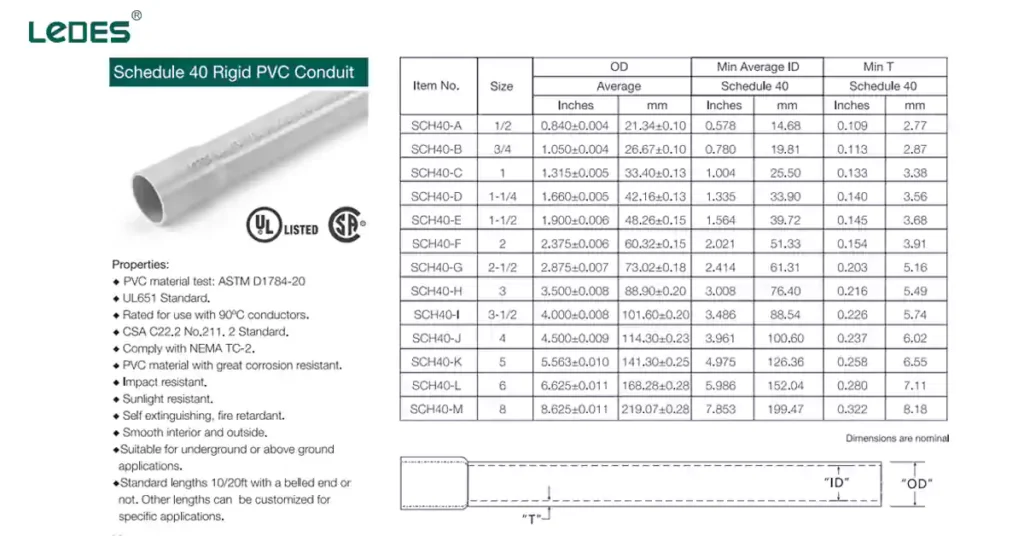
Dimensões do eletroduto de PVC do Anexo 40
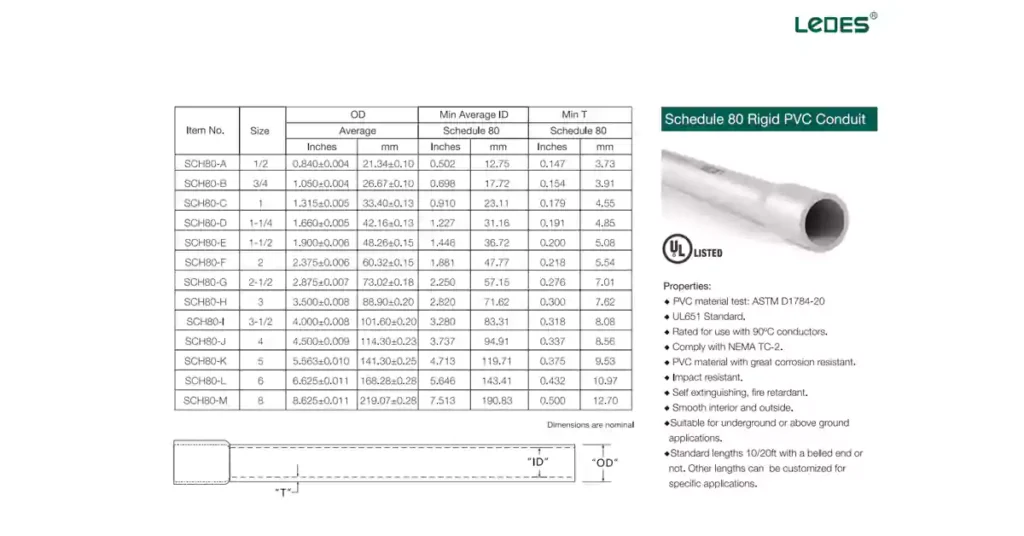
Dimensões do eletroduto de PVC Schedule 80
Conduíte de PVC Schedule 40 Apresenta uma parede relativamente mais fina em comparação com o Schedule 80. Essa parede mais fina torna o conduíte Schedule 40 mais leve e fácil de manusear durante a instalação. É uma escolha popular para aplicações em que o conduíte não é submetido a estresse físico significativo ou condições ambientais adversas.
Por outro lado, Conduíte de PVC Schedule 80 Possui parede mais espessa, proporcionando maior resistência mecânica e durabilidade. A espessura adicional aumenta sua capacidade de suportar pressões externas, impactos e outras forças potencialmente danosas. O conduíte Schedule 80 é comumente utilizado em aplicações com maior probabilidade de estresse físico ou exposição a ambientes agressivos, como instalações externas ou ambientes industriais.
A diferença na espessura da parede também pode impactar outros fatores, como desempenho elétrico e custo. Paredes mais espessas em conduítes do Anexo 80 podem oferecer melhores propriedades de isolamento elétrico, especialmente em situações em que há necessidade de proteção aprimorada contra interferência elétrica ou fatores externos. No entanto, é importante observar que as características específicas de desempenho e as implicações de custo podem variar dependendo do fabricante e dos requisitos específicos da aplicação.
Compreender as diferenças na espessura da parede entre os conduítes de PVC Schedule 40 e Schedule 80 é essencial para selecionar o conduíte apropriado para uma instalação elétrica específica. Fatores como condições ambientais previstas, estresse mecânico e considerações orçamentárias devem ser levados em consideração ao decidir entre as duas opções.
- O conduíte Schedule 80 demonstra maior durabilidade e resistência ao impacto em comparação ao Schedule 40.
- A norma UL 651 fornece métodos de teste para resistência ao impacto e resistência ao esmagamento, mostrando o desempenho físico superior do Schedule 80.
Além da variação na espessura da parede, os conduítes de PVC Schedule 40 e Schedule 80 também apresentam diferenças nas características de desempenho. Essas diferenças podem ser observadas por meio de métodos de ensaio como resistência ao impacto e resistência ao esmagamento, conforme descrito na norma UL 651. A comparação dos valores obtidos nesses ensaios demonstra claramente que o conduíte Schedule 80 oferece desempenho físico superior.
Em termos de resistência ao impacto, o conduíte de PVC Schedule 80 demonstra maior durabilidade em comparação ao Schedule 40. Os testes de resistência ao impacto avaliam a capacidade do conduíte de suportar forças externas, como batidas ou impactos acidentais. Devido à sua parede mais espessa, o conduíte Schedule 80 apresenta maior resistência a danos causados por impactos, tornando-o uma escolha adequada para aplicações com maior risco de estresse físico.
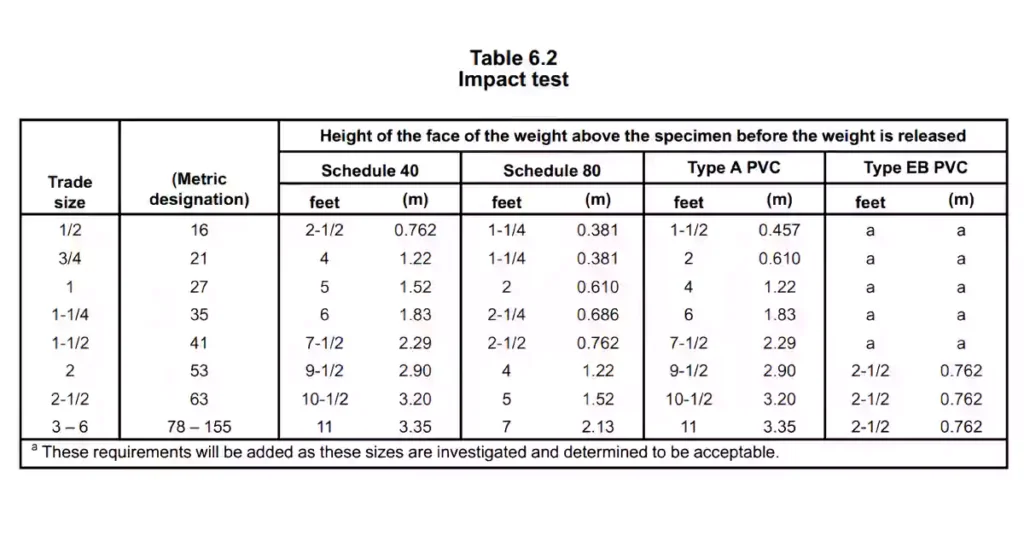
Esses dados vêm da oitava edição de PADRÃO UL 651 DE SEGURANÇA, e a propriedade pertence à UL.
De acordo com a norma UL 651, o teste de impacto para eletrodutos de PVC rígido é realizado da seguinte forma:
- Dez espécimes de 6 polegadas (150 mm) sem rachaduras, rasgos ou imperfeições são cortados de comprimentos acabados de cada tamanho comercial de conduíte rígido de PVC.
- As amostras são condicionadas ao ar a uma temperatura de 23,0 ±0°C (73,4 ±3,6°F) por no mínimo 4 horas antes do teste.
- Os espécimes são testados individualmente dentro de 15 segundos após o condicionamento, enquanto repousam sobre uma placa de aço sólida e plana, com pelo menos 1/2 polegada (13 mm) de espessura e firmemente ancorada com sua superfície superior horizontal.
- Uma gaiola protetora envolve as placas e amostras para reduzir o risco de ferimentos causados por pedaços quebrados do conduíte.
- Um peso de aço, na forma de um cilindro sólido, circular reto, com uma face de impacto plana e bordas arredondadas, cai livremente através de uma guia vertical de uma altura especificada, de acordo com a Tabela 6.2 da norma UL 651.
- Para conduítes de PVC rígido do Anexo 40, Tipo A e EB, o peso é de 9,7 kg (20 lbs) com um diâmetro de cilindro de 51 mm (2 polegadas). Para conduítes do Anexo 80, o peso é de 34 kg (75 lbs) com um diâmetro de cilindro de 150 mm (6 polegadas).
- A face plana do peso atinge o centro da amostra ao longo do diâmetro e ao longo do eixo longitudinal uma vez, garantindo que o peso não atinja a amostra mais de uma vez.
- O conduíte rígido de PVC não deve apresentar rachaduras ou rasgos maiores que 1/32 polegada (0,8 mm) ao longo da superfície externa em mais de três dos dez espécimes.
De acordo com a norma UL 651, o teste de esmagamento para conduíte rígido de PVC é realizado da seguinte forma:
- Amostras de seis polegadas (150 mm) de conduíte de PVC rígido acabado são testadas.
- Os espécimes não devem achatar a ponto de encurvar sob a carga especificada na Tabela 6.3.
- O eixo menor medido dentro de cada amostra carregada não deve ser menor que 70% do diâmetro interno da amostra medido antes do carregamento.
- Três espécimes são cortados de comprimentos acabados de cada tamanho de conduíte rígido de PVC.
- As amostras, a máquina de teste e o ar ao redor devem estar em equilíbrio térmico a uma temperatura de 23,0 ±2,0°C (73,4 ±3,6°F) durante o teste.
- O diâmetro interno de cada espécime é medido antes do teste.
- Os espécimes são testados individualmente entre um par de placas de aço rígidas e planas, com pelo menos 150 mm de comprimento, horizontais e paralelas entre si.
- Uma placa é movida em direção à outra a uma taxa de 1/2 ±1/8 polegada (10,0 ±2,5 mm) por minuto até que a carga especificada na Tabela 6.1 seja aplicada, conforme indicado no mostrador da máquina de teste.
- O conduíte rígido de PVC não deve apresentar sinais de afastamento devido ao contato com nenhuma das placas durante ou após a aplicação da carga (flambagem).
- O eixo menor medido dentro de qualquer espécime achatado não deve ser menor que a porcentagem especificada na Tabela 6.3 do diâmetro interno daquele espécime, medido antes do carregamento.
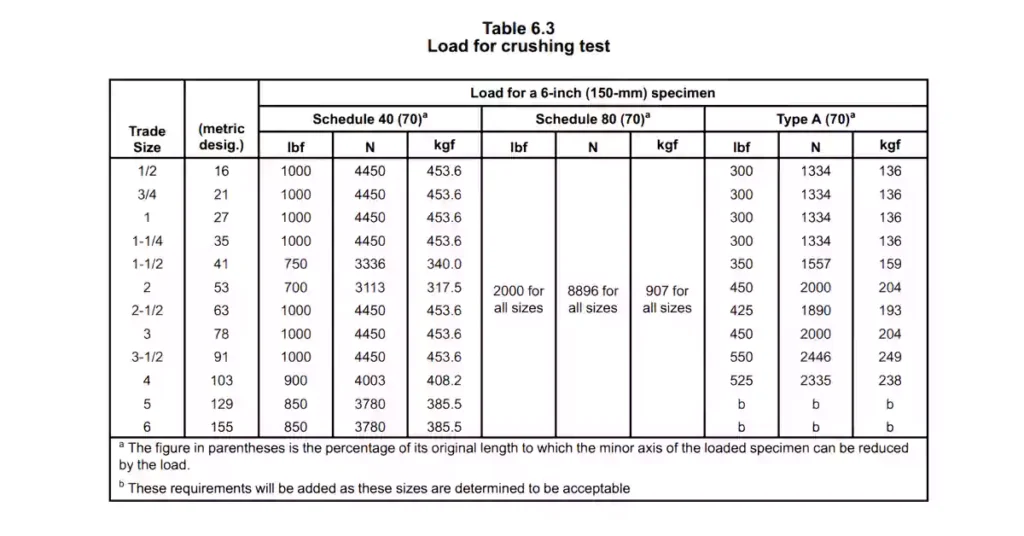
Esses dados vêm da oitava edição de PADRÃO UL 651 DE SEGURANÇA, e a propriedade pertence à UL.
Vale a pena notar que fabricantes de conduítes de PVCAssim como a Ledes, investimos continuamente em pesquisa e desenvolvimento para garantir que o aumento da espessura da parede dos conduítes Schedule 80 seja acompanhado por um desempenho consistente em todos os aspectos. Esse compromisso com o aprimoramento do produto garante que o conduíte atenda e, muitas vezes, exceda os padrões de certificação UL, além de superar as expectativas do cliente.
Por exemplo, as séries de conduítes de PVC Schedule 40 e Schedule 80 da Ledes foram implantadas e utilizadas com sucesso em projetos de destaque, como a CHPE e a AB Brown Station, nos Estados Unidos. Esses projetos demonstraram que os conduítes da Ledes não apenas atendem aos padrões de certificação UL, mas também superam as expectativas dos clientes em termos de desempenho geral e confiabilidade.
Ao compreender as diferenças de desempenho entre os conduítes de PVC Schedule 40 e Schedule 80, torna-se evidente que a seleção do conduíte apropriado deve levar em consideração os requisitos específicos da instalação elétrica. Fatores como estresse físico previsto, condições ambientais e padrões da indústria devem ser cuidadosamente considerados para garantir o desempenho ideal e a longevidade do sistema de conduítes.
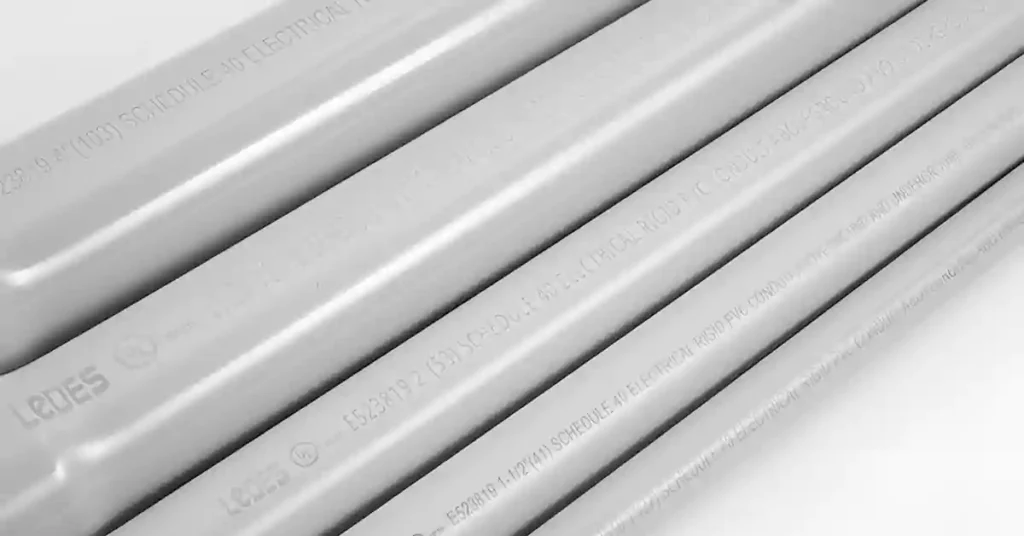
- O conduíte Schedule 80 geralmente é mais caro devido à maior espessura de parede e aos requisitos de material.
Com base na análise e comparação anteriores, pode-se concluir que o Schedule 80 é geralmente mais caro que o Schedule 40. Essa diferença de preço se deve principalmente à maior espessura da parede e aos maiores requisitos de material associados ao conduíte Schedule 80.
A parede mais espessa do conduíte Schedule 80 requer mais matéria-prima, o que contribui para seu maior custo de fabricação. Além disso, os processos de produção do conduíte Schedule 80 podem envolver etapas adicionais ou equipamentos especializados para atingir a espessura desejada, o que aumenta ainda mais o custo total.
Além disso, o aumento de peso do conduíte Schedule 80, resultante de sua parede mais espessa, pode levar a custos mais elevados de transporte e manuseio durante a instalação. O peso adicional exige mais esforço e recursos para transporte, manuseio e içamento, o que pode gerar despesas adicionais.
Como resultado, muitos projetos optam por eletrodutos do Anexo 40 por oferecerem uma solução econômica, além de atenderem aos requisitos necessários. Os eletrodutos do Anexo 40 são amplamente utilizados em diversas aplicações onde a maior resistência e durabilidade do Anexo 80 podem não ser essenciais.
No entanto, é importante observar que a seleção do tipo de conduíte deve considerar as necessidades e os requisitos específicos do projeto. Caso o seu projeto tenha considerações ou demandas especiais, recomendamos que você nos consulte para obter informações e orientações mais detalhadas.
Em última análise, equilibrar os requisitos de desempenho com os custos associados é crucial para tomar uma decisão informada sobre qual cronograma de conduíte de PVC é mais adequado para sua aplicação específica.
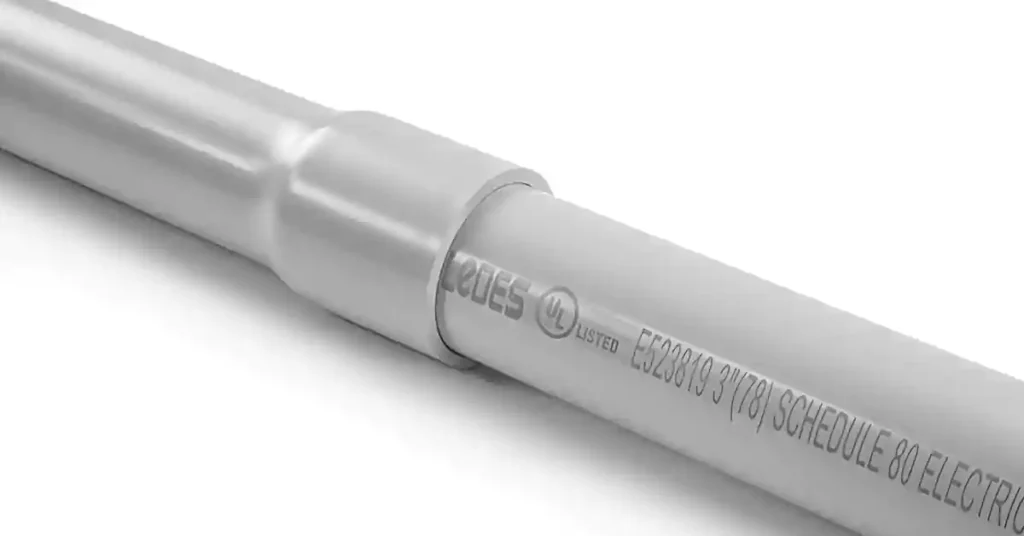
- Ambos os tipos de conduíte têm dimensões idênticas e podem usar os mesmos acessórios para conexões.
- Práticas adequadas de instalação devem ser seguidas de acordo com os códigos e diretrizes locais relevantes.
Como a UL e as normas relacionadas definem que os conduítes Schedule 40 e Schedule 80 têm dimensões idênticas, isso significa que podem usar os mesmos acessórios para conexões. No entanto, é importante seguir as normas relevantes de cada país durante o processo de instalação.
Nos Estados Unidos, o Código Elétrico Nacional (NEC) fornece diretrizes para a instalação adequada de conduítes de PVC. Essas diretrizes incluem instruções para a limpeza do conduíte, a realização de conexões e a garantia da segurança elétrica geral.
Aqui estão 8 dicas para a instalação dos conduítes do Anexo 40 e do Anexo 80:
- Planejamento e Design: Determine o tamanho e a rota adequados do conduíte para a instalação elétrica. Considere fatores como o número e o tamanho dos condutores, as condições ambientais e quaisquer requisitos específicos do projeto.
- Corte e alargamento: Use ferramentas apropriadas para cortar seções de conduíte nos comprimentos desejados. Após o corte, remova quaisquer rebarbas ou arestas afiadas usando uma ferramenta de alargamento ou lima para garantir uma superfície lisa e limpa para encaixes e conexões adequados.
- Limpeza: Limpe completamente o interior do conduíte usando um solvente ou limpador adequado para remover quaisquer detritos, sujeira ou umidade que possam dificultar a instalação ou afetar o desempenho elétrico.
- Acessórios e conexões: Selecione conexões compatíveis com o tipo de conduíte escolhido (Schedule 40 ou Schedule 80). Siga as instruções do fabricante para fazer conexões seguras e estanques, como usar cola solvente ou conectores mecânicos.
- Suporte adequado: Instale os suportes para os conduítes em intervalos apropriados para garantir o alinhamento adequado e evitar flacidez ou tensão excessiva nos conduítes. Siga os códigos e regulamentos de construção locais em relação ao espaçamento dos suportes e aos métodos de fixação.
- Dobrando: Se necessário, utilize técnicas e ferramentas de dobra adequadas para criar curvas no conduíte. Evite dobras excessivas, pois podem enfraquecer o conduíte e afetar seu desempenho geral.
- Aterramento: Siga o NEC ou os códigos locais relevantes para os requisitos de aterramento. Conecte e aterre adequadamente o sistema de conduíte para garantir a segurança elétrica.
- Vedação e Proteção: Utilize métodos de vedação adequados, como selantes ou juntas compatíveis com PVC, nos pontos de entrada para proteger contra a entrada de umidade. Instale o conduíte em locais onde esteja adequadamente protegido contra danos físicos, como impactos ou exposição a elementos agressivos.
Consulte e siga sempre as diretrizes e regulamentações específicas fornecidas pelas autoridades e organizações de normalização relevantes do seu país ou região. Práticas adequadas de instalação são cruciais para manter a integridade e a segurança do sistema de conduítes elétricos.
Dicas profissionais: Quer saber mais sobre instalação de eletrodutos? Preparamos um guia completo para instalação de eletrodutos de PVC para você. você pode clicar para ir até lá.
- O conduíte Schedule 40 é adequado para aplicações residenciais, comerciais e industriais leves, bem como instalações internas e áreas de pouco tráfego.
- O conduíte Schedule 80 é preferido para instalações industriais pesadas, plantas químicas, instalações externas e subterrâneas, locais perigosos e salas mecânicas.
O conduíte de PVC Schedule 40 protege e direciona com segurança a fiação elétrica em paredes, pisos, tetos e até mesmo aplicações de enterramento direto, atendendo aos padrões NEC 352 para uso residencial, comercial e industrial.
- Edifícios residenciais: O eletroduto Schedule 40 é comumente utilizado em construções residenciais para instalações elétricas. É adequado para ambientes residenciais típicos, onde o risco de danos físicos ou condições extremas é relativamente baixo.
- Edifícios comerciais: Em áreas de baixa demanda de estruturas comerciais, como escritórios, lojas de varejo ou pequenas empresas, o conduíte Schedule 40 é frequentemente utilizado. Ele fornece proteção adequada para a fiação elétrica sem a necessidade da resistência reforçada do Schedule 80.
- Instalações Industriais Leves: Certas aplicações industriais leves, como oficinas ou instalações de fabricação de pequena escala, onde o risco de impacto ou condições extremas é mínimo, podem se beneficiar da relação custo-benefício do conduíte Schedule 40.
- Instalações internas: O conduíte Schedule 40 é comumente usado em instalações elétricas internas, incluindo fiação em paredes, tetos e pisos, onde fornece proteção contra danos físicos e ajuda a organizar e direcionar os fios elétricos de forma eficiente.
- Áreas de baixo tráfego: Locais com tráfego mínimo de pedestres, como depósitos ou armários de utilidades, onde o conduíte tem menor probabilidade de ficar exposto a impactos acidentais, podem utilizar o conduíte Schedule 40 devido ao seu menor custo e capacidade de proteção suficiente.
O conduíte Schedule 80 protege e direciona com segurança a fiação elétrica em paredes, pisos, tetos e até mesmo aplicações de enterramento direto, atendendo aos padrões NEC 352 para uso residencial, comercial e industrial.
- Instalações Industriais Pesadas: O conduíte Schedule 80 é frequentemente utilizado em ambientes industriais pesados, onde há maior risco de impacto, exposição a produtos químicos, temperaturas extremas ou maior estresse mecânico. Ele oferece proteção superior para a fiação elétrica nesses ambientes exigentes.
- Plantas químicas e instalações de processamento: Ambientes com substâncias ou produtos químicos corrosivos exigem o uso de conduítes Schedule 80 para suportar os potenciais efeitos corrosivos e fornecer proteção robusta para sistemas elétricos.
- Instalações externas e subterrâneas: O conduíte Schedule 80 é indicado para aplicações externas e subterrâneas, onde pode ficar exposto à radiação UV, umidade, pressão do solo ou a possíveis danos causados por atividades de escavação. Oferece maior durabilidade e resistência a forças externas.
- Locais perigosos: Áreas classificadas como perigosas, como refinarias de petróleo, plantas petroquímicas ou instalações com gases ou poeira inflamáveis, exigem maior resistência e durabilidade dos conduítes Schedule 80 para garantir a segurança dos sistemas elétricos.
- Salas Mecânicas e Equipamentos: O conduíte Schedule 80 é adequado para abrigar fiação elétrica em áreas com equipamentos mecânicos pesados, como geradores, bombas ou máquinas industriais, onde há vibrações e tensões mecânicas.
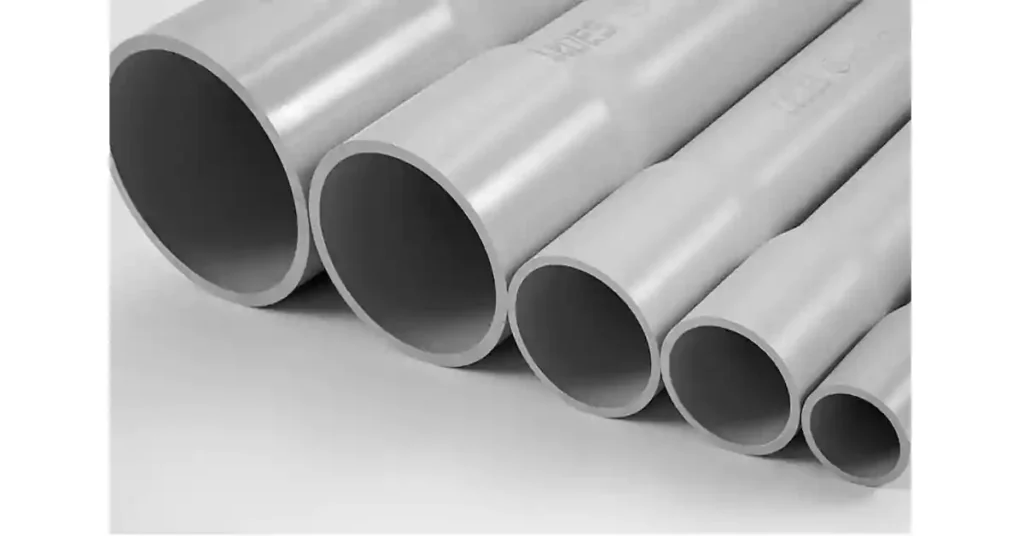
- Fornecedor de marca confiável: Escolher um fornecedor de marca confiável é crucial na compra de eletrodutos. Uma marca conceituada como a Ledes, por exemplo, tem um histórico de entrega de produtos e soluções de alta qualidade. Reconhecida por seu compromisso com a excelência e a inovação, a Ledes oferece uma gama completa de sistemas de eletrodutos projetados para atender aos padrões da indústria e garantir instalações elétricas confiáveis.
- Conformidade com os padrões locais de construçãoÉ essencial garantir que o conduíte elétrico que você comprar esteja em conformidade com as normas e códigos de construção locais. Por exemplo, nos Estados Unidos, o Código Elétrico Nacional (NEC) define os padrões para instalações elétricas. O conduíte que você escolher deve atender aos requisitos do NEC para garantir a segurança e a conformidade com as regulamentações locais.
- Serviços prestados pelo fornecedor: Além do produto em si, considere os serviços prestados pelo fornecedor. Isso inclui fatores como transporte, entrega e suporte pós-venda. Um fornecedor confiável oferecerá opções de transporte eficientes, garantindo que o conduíte chegue ao seu local em tempo hábil. Ele também deve ter uma equipe de atendimento ao cliente ágil e disponível para responder a quaisquer dúvidas ou problemas que você possa ter após a compra.
- Qualidade e durabilidade do produto: Avalie a qualidade e a durabilidade do eletroduto oferecido. Procure produtos que tenham passado por testes rigorosos, como testes de resistência a chamas e testes de temperaturas extremas. Eletrodutos de alta qualidade garantem um desempenho duradouro, reduzindo a necessidade de substituições e manutenções frequentes.
- Compatibilidade e Versatilidade: Considere a compatibilidade e a versatilidade do sistema de conduítes elétricos. Ele deve ser capaz de acomodar diversos tipos de fiação e ser adequado para diferentes aplicações. Escolher um sistema de conduítes com uma ampla gama de conexões e acessórios proporcionará flexibilidade na instalação e atenderá aos requisitos específicos do seu projeto.
No geral, os eletrodutos elétricos são uma parte importante dos sistemas elétricos. Os eletrodutos de PVC Schedule 40 e Schedule 80 são os dois tipos de eletrodutos mais utilizados no mercado. Eles compartilham as mesmas funções e propriedades, mas diferem em detalhes de desempenho, dimensões e aplicações. Ao escolher esses dois tipos, considere as necessidades e os requisitos específicos do seu projeto para escolher o mais adequado.
É isso. Sinta-se à vontade para entrar em contato conosco se tiver alguma dúvida. Você pode simplesmente envie um e-mail para nós.



